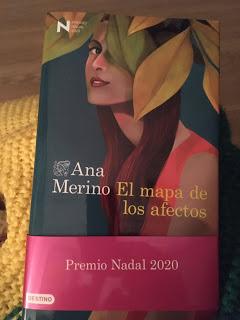
258 palabras, un minuto de lectura.
En el panorama de narrativas contemporáneo destaca Ana Merino con su reciente premio Nadal por El mapa de los afectos, un libro escrito por una autora que sabe lo que dice y lo sabe decir. Nos comparte la visión de una catedrática de escritura creativa en Iowa, por un lado ofreciendo su oficio de escritora, por otro el hecho de ser ciudadana del medio oeste americano que será el escenario de la obra. La composición del texto en capítulos prácticamente independientes hace que sea muy fácil de leer a lo que ayuda el maduro uso del lenguaje, la economía de medios superfluos y la enorme base poética de la autora. La trama y los personajes permiten ofrecer un abanico de acciones y escenas donde cabe la vida y la muerte, el horror y la ternura. No es un libro sobre la bondad, más bien sobre la humanidad que contiene siempre un lado de luz y otro de sombra. Tampoco se puede decir que ganen los buenos, en eso se aleja del discurso manido de tanta cultura cinematográfica de masas y se acerca a la vida misma que, a mi criterio, dibuja con delicadeza y precisión. Creo que los lectores reconocerán a los numerosos personajes que les recordaran familiares, amigos o conocidos, además de encontrar en sus gestos o circunstancias vivencias propias similares. Porque este libro es a fin de cuentas como un pantallazo de un GPS convertido en un gran mapa de humanidad, algo que solo se puede hacer con la magia de la gran literatura.
Human cartographies
In the contemporary narrative scene, Ana Merino stands out with her recent Nadal Award for El mapa de los afectos, a book written by an author who knows what she is saying and can say it properly. She shares with us the vision of a professor of creative writing in Iowa, on the one hand offering her craft as a writer, on the other hand the fact of being a citizen of the American Midwest that will be the scene of the work. The composition of the text in practically independent chapters makes it very easy to read which is helped by the mature use of language, the economy of superfluous means and the enormous poetic base of the author. The plot and characters allow for a range of actions and scenes where life and death, horror and tenderness fit. It is not a book about goodness, but rather about humanity that always contains one side of light and the other of shadow. Nor can it be said that the good guys win, moving the text away from the hackneyed discourse of so much mass film culture and stands closer to life itself which, in my opinion, draws with delicacy and precision. I believe that readers will recognize the many characters who remind them of family members, friends or acquaintances, as well as find similar experiences of their own in their gestures or circumstances. Because this book is ultimately like a screenshot of a GPS turned into a great map of humanity, something that can only be done with the magic of great literature.
人類製圖
這段文字是原汁原味的翻譯,對不起我的錯誤。
在當代敘事場景中,安娜·梅里諾(Ana Merino)憑藉她最近獲得的《 mapa de los afectos》獎而脫穎而出。她與我們分享了在愛荷華州從事創意寫作的教授的願景,一方面提供她作為作家的手藝,另一方面也成為成為美國中西部公民的事實。文本在幾乎獨立的章節中組成,使得閱讀起來非常容易,這得益於語言的成熟使用,多餘手段的經濟性和作者巨大的詩歌基礎。劇情和角色允許進行各種動作和場景,以適應生與死,恐怖和溫柔。這不是一本關於善的書,而是一本關於人類的書,它總是包含光的一面和陰影的另一面。也不能說好人獲勝,將文字從如此眾多的大眾電影文化的陳腐話語中移開,並且更貼近生活本身,在我看來,這是精緻而精確的。我相信讀者會認識到許多使他們想起家庭成員,朋友或相識的人物,並在他們的手勢或環境中發現自己的類似經歷。因為這本書最終就像是GPS的屏幕截圖,變成了一張偉大的人類地圖,所以只有借助出色的文學才能做到這一點。 Y si te atreves con la poesía te comparto una propuesta personal: https://youtu.be/MjrWKFOaJXo
